Story of Day :
Lilies are popular ornamental plants among Europeans. The scientific name Lilium spp. is included in the category of bulbous plants.
This flower originated in northern Europe and spread to North America and Japan. In Asia, this flower is typically imported directly from the country of origin. In general, the Oriental Trumpet Asiatic and Longilflorum.
Many of them are used as cut flowers. If it hasn’t blossomed, the blossoms resemble a funnel-shaped taper. Most are predominantly white but have been bred into a variety of colors.
Contents
- 1 Types of Lilies
- 1.1 African Queen Group
- 1.2 Casa Blanca Lily
- 1.3 Fatamorgana Lily
- 1.4 Garden Party
- 1.5 Golden Splendor Group
- 1.6 Lilium Henry
- 1.7 Lilium Mackliniae
- 1.8 Lilium Martagon
- 1.9 Lily Pardalium
- 1.10 Pink Perfection Group
- 1.11 Lilium Regale
- 1.12 Lilium Amabile
- 1.13 Lilium Bulbiferum
- 1.14 Lilium Callosum
- 1.15 Lilium Cernuum
- 1.16 Lilium Concolor
- 1.17 Lilium Pensylvanicum
- 1.18 Lilium Davidii
- 1.19 Lilium x hollandicum
- 1.20 Lilium Lancifolium
- 1.21 Lilium Lankongense
Types of Lilies
African Queen Group
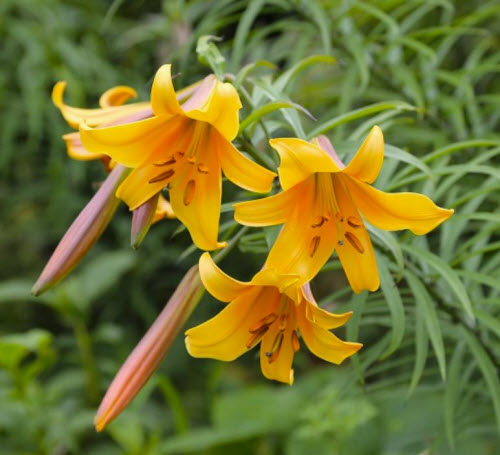
The tall, upright stems of this bulbous perennial produce large, fragrant trumpets in the summer.
When paired with other brightly colored plants in a herbaceous border, they’re a lovely addition to any garden.
Casa Blanca Lily
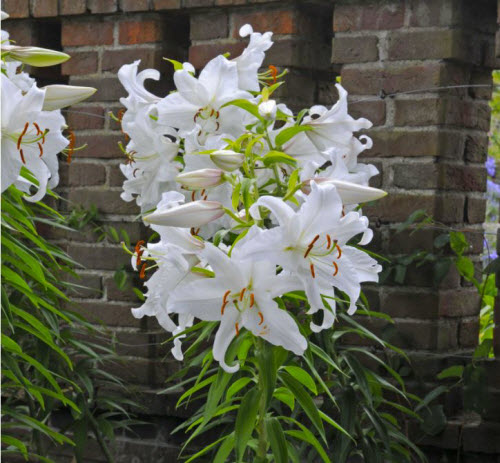
For many years now, Lilium Casa Blanca has been the most popular lily cut flower. Lily Casa Blanca can also be grown in the yard.
A mature Lilium Casa Blanca will produce ten to fifteen flowers per bulb. In five, six, or seven years’ time, if Casa Blanca is still blooming in your yard, you might think of me.
Fatamorgana Lily
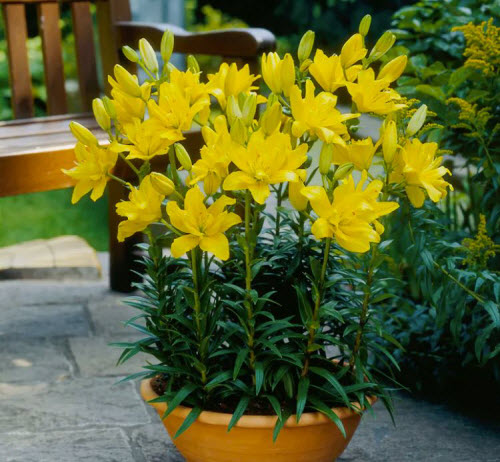
Known for its bright yellow blooms and slender stalks, Fata Morgana is an Asiatic Double Lily from the region. These pollen-free double blooms are the perfect choice for a long-lasting cut flower. A height of 30 to 36 inches.
Garden Party
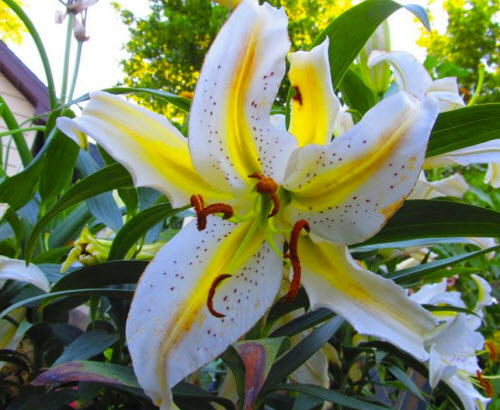
Summer is a great time of year to see large, beautiful Oriental lilies in bloom.
To brighten the summer landscape from July to August, Garden Party is held. Lilies with large white petals have lime-green throats encircled by red speckles.
A soft apricot color develops as the yellow markings age. Those beautiful pinwheel-shaped flowers are positioned to face outwards. The front of a sunny border is the best place to plant Garden Party. This is a great variety for large-scale plantings.
Also, read about 15 of the most beautiful flowering cactus plant.
Golden Splendor Group
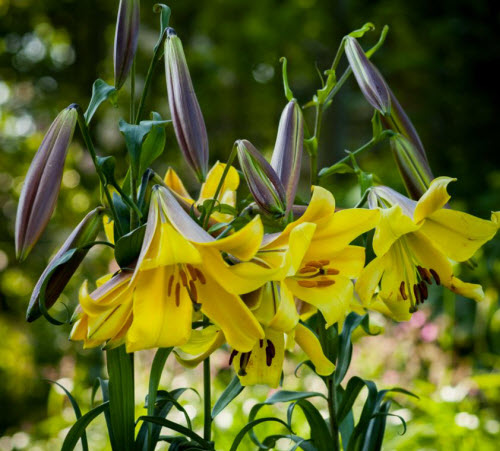
Once established, Aurelian/trumpet hybrid lilies can grow up to 9′ tall. These plants are marketed as ‘Golden Splendour.’
Flowers are large trumpet-shaped (6-8″) with variegated maroon striping. Summer flowers umbels on stiff, leafy stem 12-20 blooms on each Lovely stem flower. DeGraaf’s first hybrid.
Lilium Henry
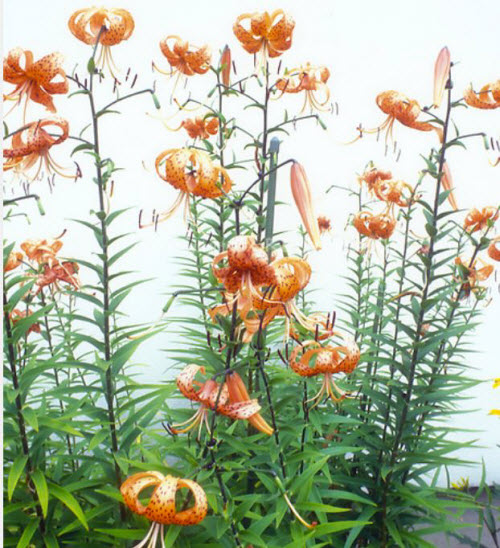
The Lilium Henryi, or tiger lily, is recognized as Henry’s or Henry’s lily because it is native to central China. Unscented orange flowers with maroon spots have no scent at all.
In the end, the petals resemble Turk’s-cap lilies, which are generally seen.
Lilium Mackliniae
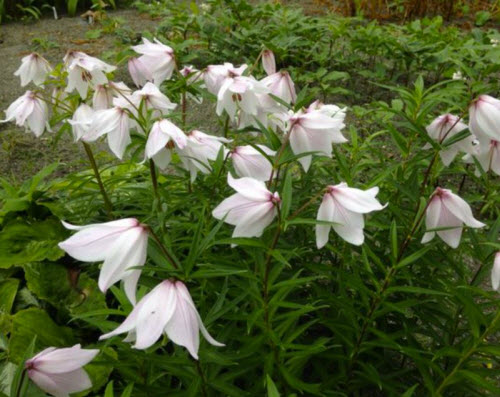
When the petals of this shade-loving lily are expanded to their maximum extent, seven hues can be visible. This plant is at its best between June and July.
If you’d like to catch them in full bloom, the months of May and June are your best bet. It’s in full bloom from May 15 until June 5.
The plant can grow to a height of one to three feet (0.3–0.91 m), depending on the variety. A single plant can produce anywhere from one to seven flowers.
Lilium Martagon
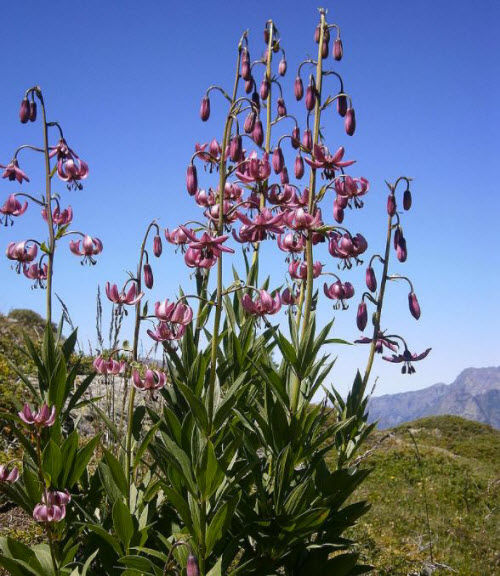
Spectacular Lilium martagon can be found in Swiss mountain meadows. Purple Turk’s cap lilies bloom on this plant’s dark green foliage throughout the summer. It looks gorgeous if you slice it up and put it in a vase.
As long as it’s partially shaded, it’s perfect. For enhanced drainage in the winter, sand the planting hole.
During the fall and early spring, you can begin planting.
The plant and its pollen are toxic to cats.
Lily Pardalium
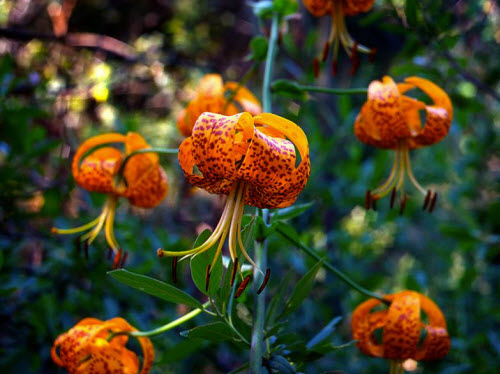
Most Lily Pardalinum plants are between 6 and 8 feet tall; the tallest and most vigorous can grow up to 2.5 meters in height (8.2 ft).
It’s perfect for container gardening because the bulbs are petite and crowded together.
Turk’s cap flowers bloom in July with numerous brown dots and orange petals.
Known as the leopard lily, the Lily Pardalium lives in Oregon and California. Search throughout the California coast ranges as well as the Klamath and Sierra Nevada ranges.
Pink Perfection Group
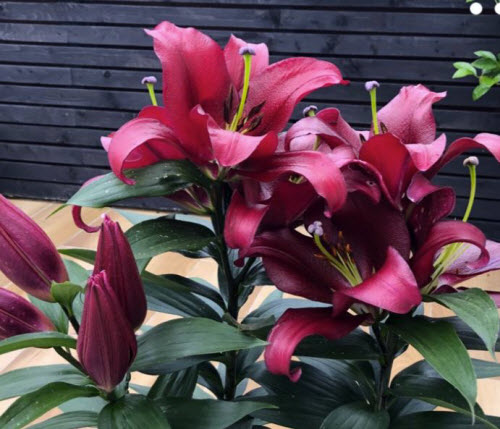
Large, trumpet-shaped, purple-pink flowers with vivid orange anthers adorn this lovely lily. For the rear of a sunny border, a 2m (6ft) tall lily with gorgeous midsummer blooms is suitable.
The huge, beautiful blossoms on these lilies make them ideal for cutting.
Lilium Regale
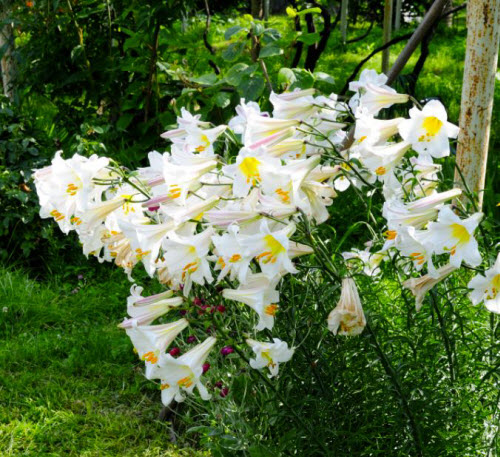
In China, the trumpet lily (Lilium regale) is known as the “regal lily” since it is found only in the western Sichuan Province of southwestern China. Ernest Henry Wilson brought it to the United Kingdom in 1903.
It can reach heights of 3-5 feet (sometimes up to 6 feet). A yellow neck and an outer purple tinge can be found on the fragrant white trumpets, which measure 6-8 inches in length.
In the spring, the flowers begin to bloom. On average, there are 25 blossoms on each stalk. Trimmed flower with a long shelf life.
Lilium Amabile
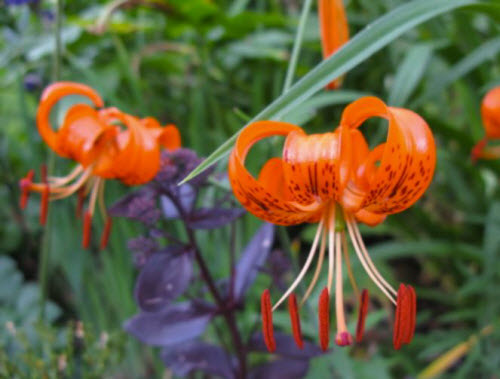
This plant can grow up to 80 centimeters in height (31 in). 2.5 centimeters (1 in) to 3 centimeters (1 in) in diameter are the bulb’s dimensions (1.2 in).
It is possible to have the flowers in either single or a three-flower raceme. Red, dark red-orange or yellow sepals and petals are the most common, but other colors are possible.
The plant’s rotten smell has long been a complaint against it.
Lilium Bulbiferum

Lilium bulbiferum grows to a maximum height of 120cm, with an average height of 20–90 cm (7.9–35.4 in) (47 in). Leaves up to 10 cm long can be found on the plant’s tall, erect stem.
1-5 short-haired flowers make up the inflorescence. In total, there are six erect tepals, the exterior of which is slightly narrower than the inside.
Bright yellow-orange flowers with reddish-brown spots measure 4–6 cm long. The anthers are crimson and the stamens are erect. It’s 35 mm tall and orange in color (1.4 in). The flowering season lasts from May through July.
Lilium Callosum
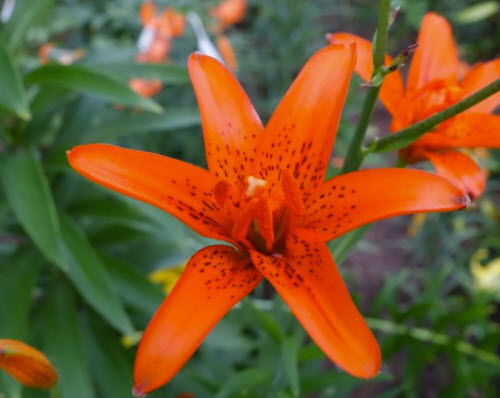
It is unusual to find Lilium callosum bulbs, which have the broadest range of any Asian species, for sale.
Turk’s cap flowers have a wonderful scent and appear to be resistant to virus infection making them a good choice for well-drained rock gardens.
Fast epigeal germination and easy seedling growth make this a popular houseplant.
Lilium Cernuum
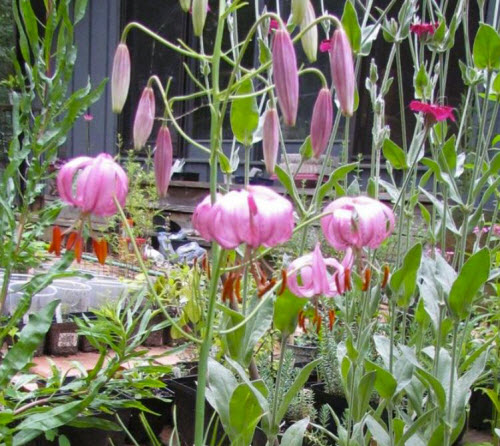
A native of Korea, Russia’s Primorye region, and northeastern China is the Lilium cernuum lily (Jilin and Liaoning provinces).
It can grow up to 50 centimeters tall. Although the flowers might be white or purple, they are most often pink with maroon spots, however, they can be any color.
Lilium pumilum is a close relative of this species in many ways. The nodding (hanging) flowers on Cernuum are what give the plant its name.
Lilium Concolor
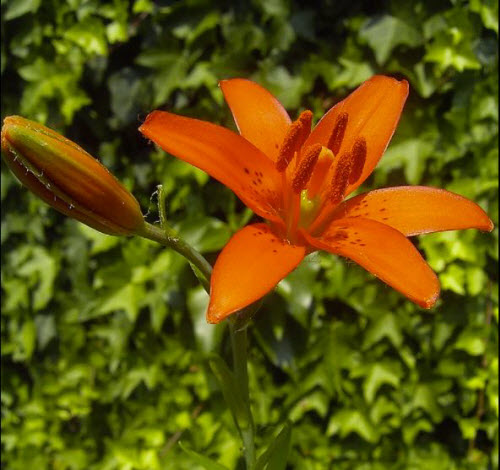
All year long, Lilium Concolor grows at heights between 350 and 2,000 meters. A terete (cylindrical) stem with 1–5 flowers per stem is 30–50 cm tall.
Purple coloring can be found around the stem’s base.
Bright, spectacular flowers in a variety of hues — orange-yellow to red with flecks of yellow — adorn this plant. Flowering in clusters of up to 10, they are called raceme or umbel flowers.
Despite their intense scent, they only appear for a brief period of time (each flower lasts only a few days). Hermaphrodites receive pollen from bees.
Tiny seeds are produced. The 3–4 cm long tepals are speckled, oval, and fuzzy on the outside.
Lilium Pensylvanicum
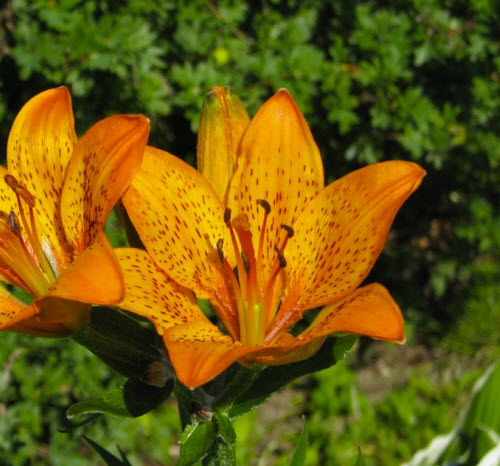
A 30–70 cm (12–28 in) (12–28 in) tall plant, Lilium pensylvanicum can reach a maximum height and breadth of 25 cm (10 in). Hard, smooth, and straight stems with linear to lanceolate leaves of 4–5 cm (1–2.0 in) long and 3–4 mm (0.12–0.16 in) wide are the characteristics of the plant’s leaves.
One to six upright, dish-shaped flowers appears in June and July on this shrub. In total, the flower has six tepals that spiral outward from the center.
Seeds mature from August through September. The bulb has a diameter of around 2 cm and is cylindrical in shape (0.79 in).
Lilium Davidii
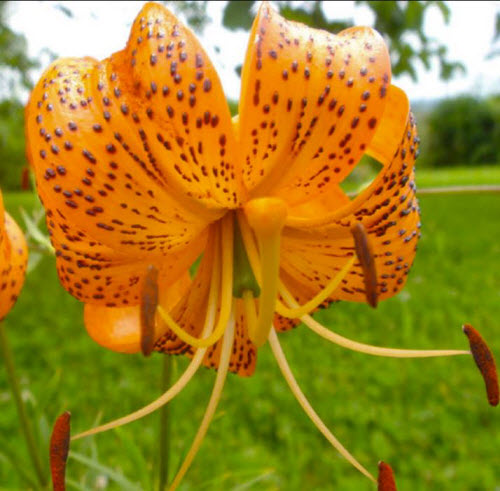
Lilium Davidii is a lily species native to the hilly regions of Arunachal Pradesh, Assam, Manipur, Tibet, Bhutan, and Hubei provinces of China.
Perennial Lilium Davidii grows to a height of 1.5 meters, bearing up to 20 of its unscented, recurved-backwards-flowering tepals in bloom from July to August.
The bulb of the plant is gathered and consumed as a vegetable. Lilies that develop bulbils (adventurous roots that emerge above the bulb) have stem-rooting roots.
Lilium x hollandicum
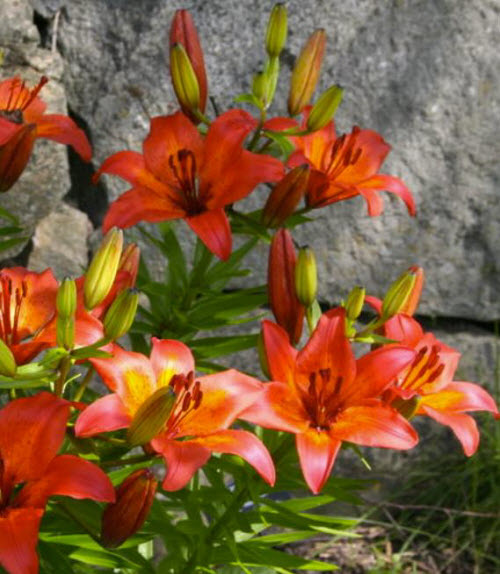
Phyllostachys spec and Cortaderia selloana, two other garden plants that may have been introduced via rhizomes from contaminated soil, are both found in the Ghent port region (Rodenhuizedok), where the species has only been found in one place.
It’s a British invention.
It’s a popular hybrid among growers. There are more flowers and leaves on the plant’s stalks than there are in L. Bulbiferum. Leaves and stems that are less hairy are prevalent.
Lilium Lancifolium
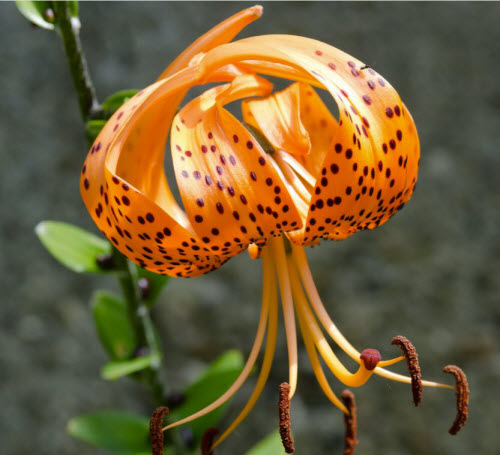
Plants with lanceolate leaves 6–10 cm long and 1–2 cm wide bear flowers on stalks 80–200 cm high.
Lilium lancifolium’s bulbils are found in the leaf axils of the plant. These bulbils create clones of the original Lilium species.
Flowers that have no scent A few days after pollination, the flowers yield capsules with thin seeds.
Lilium Lankongense
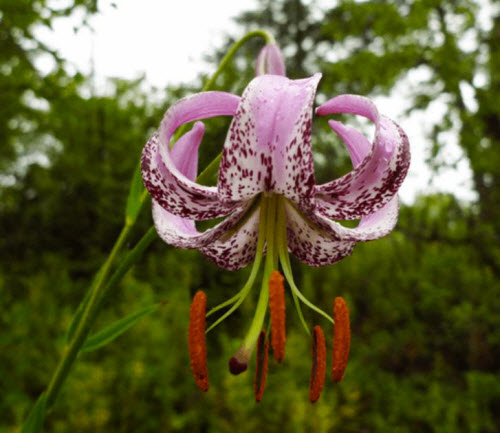
Pink and lavender flowers, accented by dark hues and beauty spots on the lower face exhale a mild fragrance that swirls around in short hints, taking this to a whole new level of pleasure.
Seed from Peter Cox’s Scottish garden was brought to Yunnan by the legendary plant collector.